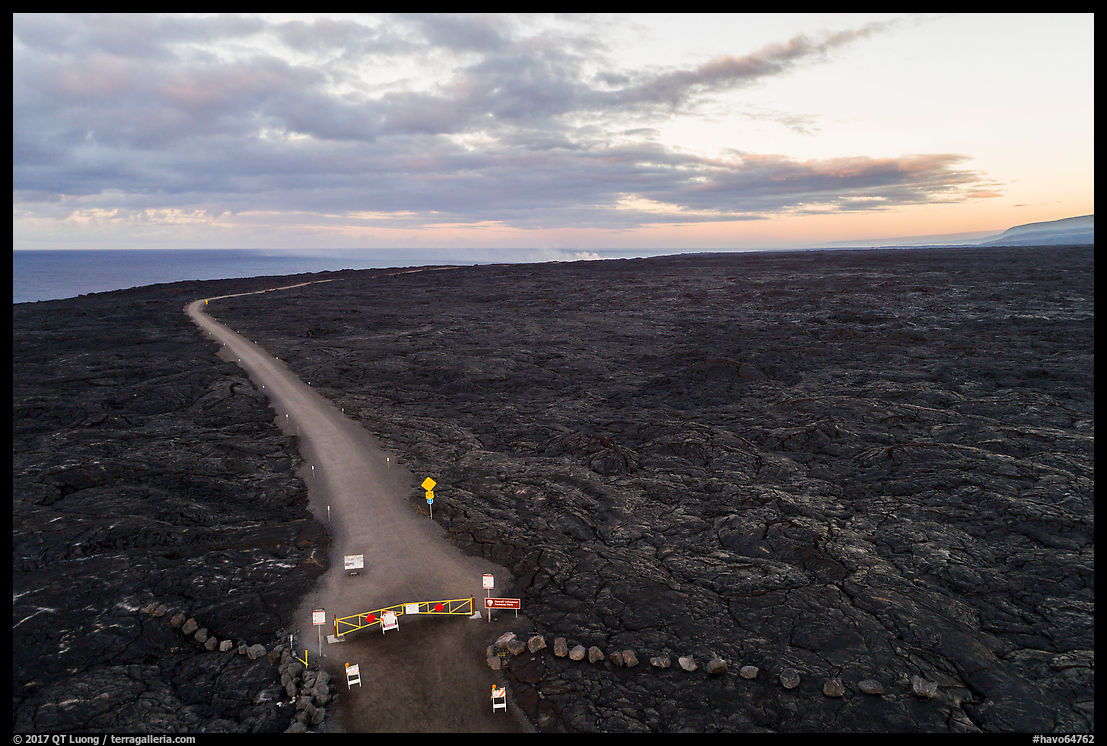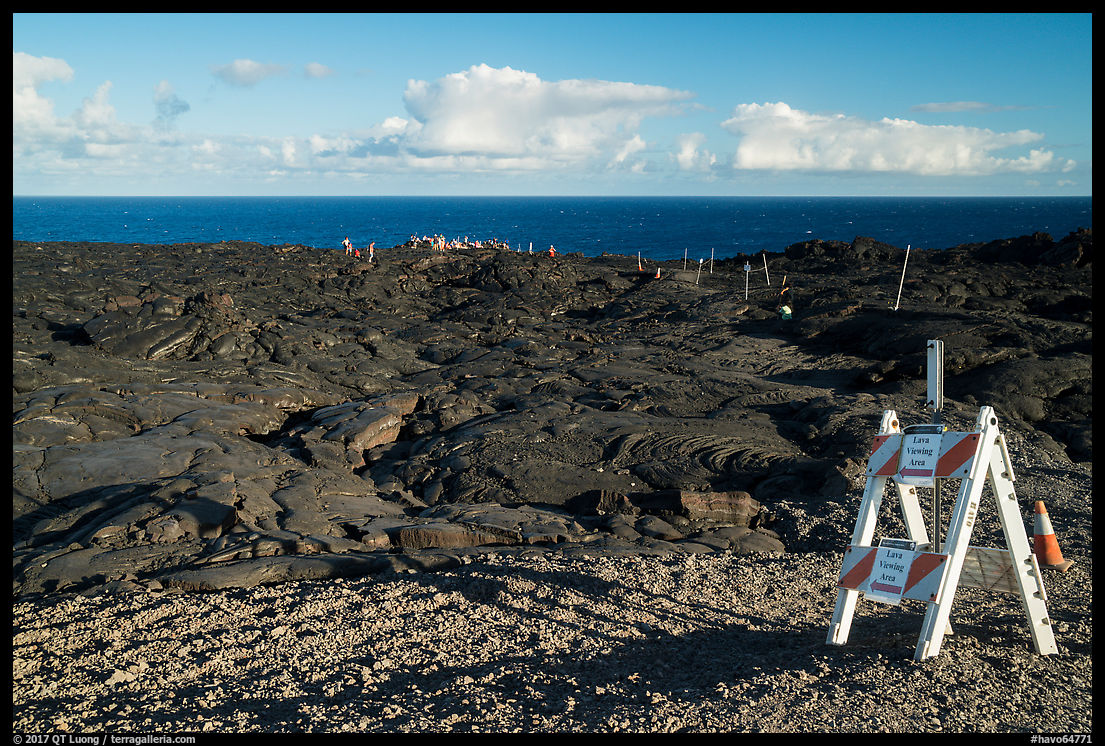New Deal on Visiting the Kamokuna Lava Flow in Hawaii Volcanoes National Park
One Comment
Accessing lava flows along the coastal plain of Hawaii Volcanoes National Park required an arduous trek during my 2013 visit, but a newly road opened has changed everything. Find why how the lava flows have never been more accessible through practical details gathered during my visit to the Kamokuna lava flow this summer.

The new emergency road
In 1959, the Chain of Craters Road connected the main entrance of Hawaii Volcanoes National Park with the tiny town of Kalapana, located along the coast, east of the park, in 26.5 miles. For most of his existence, a section of the road has been buried by new lava flows from Kilauea, the world most active volcano. That section consists of a 8-mile stretch along the coast. Since the best place to observe lava flows is that same section of the coastal plain, if the flow occured in the middle of the stretch, to see it one had to hike 4 miles one way (as I did in 2001) on trail-less and rough terrain formed by hardened lava. A tough hike!

In 2014, the buried 8-mile coastal section of the Chain of Craters Road between the park and Kalapana was rebuilt as a gravel emergency road – at a cost of between $5 millions and $12 millions depending on sources. It was meant to assist residents of lower Puna in case their access roads are cut off by lava from Kīlauea Volcano, but was partly buried again by lava in 2016. The road was not intended for visitor use. The 5.4-mile section within the park is gated and closed to motor traffic, but you are free to walk it or ride a fat-tire bike, speeding up access to the lava flows on the coastal plain.
Hiking or riding to the lava viewing area
On the park side (west), since no commercial activity is allowed, not much has changed. However, the Kalapana side (east) has seen drastic changes. There is now a huge lava viewing parking area west of Hwy 130, where visitors park along the road for up to half a mile. To reach it, continue on Hwy 130, even when the pavement ends. The area is lined up with vendors. Some are open from 4am to 10pm, and besides food, drinks, shaved ice, and souvenirs, offer bike rentals, and even a shuttle. As of the summer of 2017, the lava viewing area is about 4 miles (one-way) from the parking area, and it takes only 30 minutes to ride with a bike, whereas it was a difficult 2-3 hour hike before. Hiking on the road is also much easier than on a hardened lava field.

Past the parking area, the road is open only to residents and their guests. It continues for less than 2 miles to a gate which is locked. If you take the shuttle, that’s where you will be dropped. Some local off-the-grid residents (amongst them “Doc” with the octagonal house) offered parking on the south side of the road for $20, which you leave in a jar. There were also a few honor system roadside stands there with coolers and fruit.

From that first gate, you need to walk or ride a bike. It takes slightly more than 2 miles to an official viewing area set by the National Park Service, and in the summer of 2017, you could not continue further on the road, since the active area was closed for safety. On the way, you’ll pass the last portable toilet and another gate at the eastern boundary of Hawaii Volcanoes National Park, about 0.75 miles from the first gate.

The emergency road is two-lane 22-foot-wide and well-graded, easy for all cars and bikes with reasonably fat tires, but it has a few hills and since the rental bikes do not have gears, some visitors have to push them. It is impossible to get lost on the road, and you can easily follow it at night. Off the road, the terrain is much more difficult to walk. The official viewing area is very close to the road, but to see lava flows, when I was there you had to wander inland off the road for more than a mile.

In 2013, the daily number of visitors to the ocean entry was in the low hundreds, most of them with a guide. In 2017, that number must be in the thousands and included many families with children. Even after the sun had set, people were still starting to hike or ride from the lava viewing parking area. At sunset, you definitely feel part of a crowd, and at that time, park rangers were present at the official viewing area and even had drinking water available for unprepared visitors. Of course, you shouldn’t count of it and pack plenty for this hike in tropical weather with no shade. At sunrise, despite more pleasant temperatures, the place is much quieter, with only about a dozen present.

Viewing and photographing lava
Besides the foot access, most of my extensive write-up about photographing the lava ocean entry still applies.

The National Park Service (NPS) had closed the Kamokuna lava ocean entry area because 26 acres of the lava delta had collapsed in the winter. Just fifteen minutes before it collapsed, rangers had chased away visitors from that section, which was already roped off. These days, the NPS would rather err on the side of safety, for instance closing entirely the area around the Halemaumau Crater whereas in the 1950s, visitors came in long lines of cars to witness lava fountains in the Kilauea Iki crater from the rim.

Sony A7R2, Tamron 150-600@500mm, 1/80s at f/6.3, ISO 3200
As a result of the lava ocean entry closure, in the summer of 2017, the Kamokuna ocean entry point was more than half-a-mile away from the official viewing area. This made photography quite challenging, because you need to use a long telephoto lens (I used a 150-600mm) which is sensitive to vibrations, the area has always steady tradewinds, and the lava is most visible in times of low light, which requires longer exposures. Since it was a family vacation, I carried a medium weight series 2 tripod, but I wish I had a much more solid one! Despite high ISO, the images I made after dark had shutter speeds lower than 1/50s and were ruined by vibration. Although I was hoping for better viewing conditions, at least I was glad to be able to easily take my children to a spot where they were able to witness a lava ocean entry, however distant, with their own eyes.

Somy A7R2, Tamron 150-600@200mm, 1/80s at f/5.0, ISO 3200


WOW! Impressive photos! Thanks for sharing it!